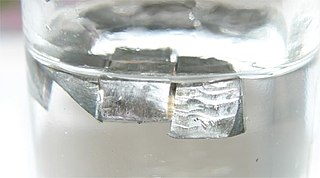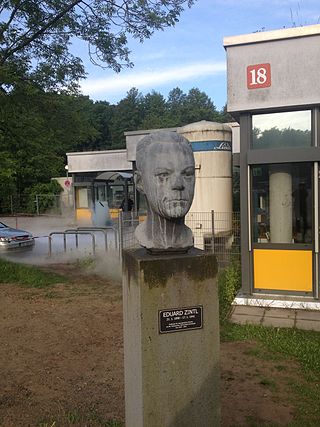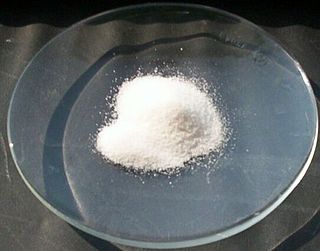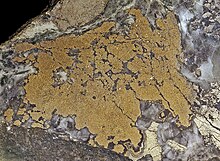
The alkali metals consist of the chemical elements lithium (Li), sodium (Na), potassium (K), rubidium (Rb), caesium (Cs), and francium (Fr). Together with hydrogen they constitute group 1, which lies in the s-block of the periodic table. All alkali metals have their outermost electron in an s-orbital: this shared electron configuration results in their having very similar characteristic properties. Indeed, the alkali metals provide the best example of group trends in properties in the periodic table, with elements exhibiting well-characterised homologous behaviour. This family of elements is also known as the lithium family after its leading element.
A metalloid is a chemical element which has a preponderance of properties in between, or that are a mixture of, those of metals and nonmetals. The word metalloid comes from the Latin metallum ("metal") and the Greek oeides. There is no standard definition of a metalloid and no complete agreement on which elements are metalloids. Despite the lack of specificity, the term remains in use in the literature.

In crystallography, the cubiccrystal system is a crystal system where the unit cell is in the shape of a cube. This is one of the most common and simplest shapes found in crystals and minerals.

Cadmium arsenide (Cd3As2) is an inorganic semimetal in the II-V family. It exhibits the Nernst effect.

A chalcogenide is a chemical compound consisting of at least one chalcogen anion and at least one more electropositive element. Although all group 16 elements of the periodic table are defined as chalcogens, the term chalcogenide is more commonly reserved for sulfides, selenides, tellurides, and polonides, rather than oxides. Many metal ores exist as chalcogenides. Photoconductive chalcogenide glasses are used in xerography. Some pigments and catalysts are also based on chalcogenides. The metal dichalcogenide MoS2 is a common solid lubricant.
In chemistry, a Zintl phase is a product of a reaction between a group 1 or group 2 and main group metal or metalloid. It is characterized by intermediate metallic/ionic bonding. Zintl phases are a subgroup of brittle, high-melting intermetallic compounds that are diamagnetic or exhibit temperature-independent paramagnetism and are poor conductors or semiconductors.

Eduard Zintl was a German chemist. He gained prominence for research on intermetallic compounds.
Zinc arsenide (Zn3As2) is a binary compound of zinc with arsenic which forms gray tetragonal crystals. It is an inorganic semiconductor with a band gap of 1.0 eV.

The metallic elements in the periodic table located between the transition metals to their left and the chemically weak nonmetallic metalloids to their right have received many names in the literature, such as post-transition metals, poor metals, other metals, p-block metals, basic metals, and chemically weak metals. The most common name, post-transition metals, is generally used in this article.
II-VI semiconductor compounds are compounds composed of a metal from either group 2 or 12 of the periodic table and a nonmetal from group 16 . These semiconductors crystallize either in the zincblende lattice structure or the wurtzite crystal structure. They generally exhibit large band gaps, making them popular for short wavelength applications in optoelectronics.

Sodium arsenide, also known as trisodium arsenide, is the inorganic compound of sodium and arsenic with the formula Na3As. It is a dark colored solid that degrades upon contact with water or air. It is prepared by the reaction of the elements at 200–400 °C. The compound is mainly of interest as exhibiting an archetypal structure. The normal pressure "sodium arsenide" phase is adopted by many alkali metal pnictides. At 3.6 gigapascals, Na3As adopts the Li3Bi structure, which is another archetypal structure. Sodium arsenide is a crystalline solid used as a semiconductor and in photo optic applications. Its IUPAC name is disodioarsanylsodium.
The term Dirac matter refers to a class of condensed matter systems which can be effectively described by the Dirac equation. Even though the Dirac equation itself was formulated for fermions, the quasi-particles present within Dirac matter can be of any statistics. As a consequence, Dirac matter can be distinguished in fermionic, bosonic or anyonic Dirac matter. Prominent examples of Dirac matter are graphene and other Dirac semimetals, topological insulators, Weyl semimetals, various high-temperature superconductors with -wave pairing and liquid helium-3. The effective theory of such systems is classified by a specific choice of the Dirac mass, the Dirac velocity, the gamma matrices and the space-time curvature. The universal treatment of the class of Dirac matter in terms of an effective theory leads to a common features with respect to the density of states, the heat capacity and impurity scattering.

Metal cluster compounds are a molecular ion or neutral compound composed of three or more metals and featuring significant metal-metal interactions.

Arsenic in the solid state can be found as gray, black, or yellow allotropes. These various forms feature diverse structural motifs, with yellow arsenic enabling the widest range of reactivity. In particular, reaction of yellow arsenic with main group and transition metal elements results in compounds with wide-ranging structural motifs, with butterfly, sandwich and realgar-type moieties featuring most prominently.
Zinc cadmium phosphide arsenide (Zn-Cd-P-As) is a quaternary system of group II (IUPAC group 12) and group V (IUPAC group 15) elements. Many of the inorganic compounds in the system are II-V semiconductor materials. The quaternary system of II3V2 compounds, (Zn1−xCdx)3(P1−yAsy)2, has been shown to allow solid solution continuously over the whole compositional range. This material system and its subsets have applications in electronics, optoelectronics, including photovoltaics, and thermoelectrics.
Arsenidosilicates are chemical compounds that contain anions with arsenic bonded to silicon. They are in the category of tetrelarsenides, pnictidosilicates, or tetrelpnictides. They can be classed as Zintl phases or intermetallics. They are analogous to the nitridosilicates, phosphidosilicates, arsenidogermanates, and arsenidostannates. They are distinct from arsenate silicates which have oxygen connected with arsenic and silicon, or arsenatosilicates with arsenate groups sharing oxygen with silicate.
Arsenidogermanates are chemical compounds that contain anions with arsenic bonded to germanium. They are in the category of tetrelarsenides, pnictidogermanates, or tetrelpnictides.
Arsenidostanates are chemical compounds that contain anions with arsenic bonded to tin. They are in the category of tetrelarsenides, pnictidostancates, or tetrelpnictides.
Lithium arsenide describes inorganic compounds with the chemical formula LixAs where x can range from about 0.5 to 3. A common derivative is Li3As, which is prepared by the reduction of arsenic with a solution of lithium in ammonia. It can also be produced by heating the elements.

Compounds of arsenic resemble in some respects those of phosphorus which occupies the same group (column) of the periodic table. The most common oxidation states for arsenic are: −3 in the arsenides, which are alloy-like intermetallic compounds, +3 in the arsenites, and +5 in the arsenates and most organoarsenic compounds. Arsenic also bonds readily to itself as seen in the square As3−
4 ions in the mineral skutterudite. In the +3 oxidation state, arsenic is typically pyramidal owing to the influence of the lone pair of electrons.

![Structure of [As7] subunit in the Zintl phase Cs2NaAs7. 423080Asonly.png](http://upload.wikimedia.org/wikipedia/commons/thumb/d/db/423080Asonly.png/220px-423080Asonly.png)









